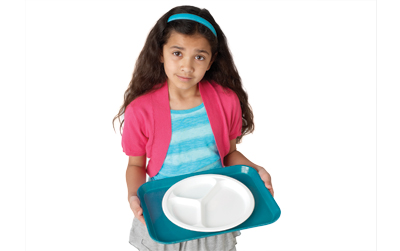Our youngest generation is facing a health crisis. Thirty-five percent of U.S. kids are overweight or obese, according to the Yale Rudd Center for Food Policy & Obesity. The Centers for Disease Control and Prevention (CDC) predicts that as many as one in three Americans will suffer from type 2 diabetes by 2050. And in 2005, for the first time in U.S. history, the CDC reported that children born today have shorter life expectancies than their parents.
Such statistics have motivated concerned citizens to take action on child nutrition, and many have found hope in a surprising place: the much derided school lunchroom. “Fixing school meals is grassroots democracy in action,” says New York University nutrition professor Marion Nestle, PhD, a noted expert on food politics. “These are places where one person can make a huge difference in what kids eat.”
Because school meals account for roughly half the calories many kids consume each day, Nestle and other activists, including First Lady Michelle Obama, have singled out lunchrooms for special attention. One is hard-pressed to find fresh fruits and vegetables among the pizza and chicken nuggets in the average cafeteria, which means a majority of those calories comes from the processed foods that experts link to obesity. “This is an extraordinary responsibility,” Obama noted in her 2010 speech to the School Nutrition Association. “But it’s also an opportunity.”
Substandard menus have been the norm in public schools since the National School Lunch Act was signed into law in 1946. The government wanted to put surplus commodity crops from its farm subsidy program to good use, and what better use than to feed hungry children? Today most children are getting plenty of calories; what they’re lacking is actual nutrition. Yet government subsidies for commodity crops continue, and those corn and soybeans still become the processed fare on most school menus. To make matters worse, state budget crises have pressured school food-service directors to cut costs by selling à la carte items from fast-food chains.
While some researchers are skeptical about the link between unhealthy school lunches and childhood obesity — a recent Penn State University study downplayed the connection — a growing number of food activists, restaurant owners, chefs, nutritionists and public-health experts are committed to improving school food. “We are seeing a healthcare crisis,” says Ann Cooper, chef, school-food advocate and coauthor of Lunch Lessons: Changing the Way We Feed Our Children. “To suggest that having unhealthy foods available to kids for six-plus hours a day has no impact on what they eat and their health just makes no sense.”
Here’s what some creative citizens are doing about school lunch, and what you can do to join them.
Healthy School-Lunch Campaigns
There are a number of campaigns around the country dedicated solely to improving school lunches. Among the first was the School Lunch Initiative in Berkeley, Calif., launched in 2004 by the Chez Panisse Foundation, the Center for Ecoliteracy and the Berkeley Unified School District. District officials hired Cooper to direct nutrition services; she brought in organic vegetables and salad bars, and eliminated trans fats, white flour and most processed food from school menus. The results were eye-opening: A 2010 report found that students from schools participating in the program expressed a higher preference for fruits and vegetables, had a greater knowledge of nutrition, and often helped prepare dinner at home using recipes they’d learned at school. Other school districts began to take notice of Cooper’s initiative. In 2009, Boulder, Colo., school officials hired her to overhaul their district’s lunch program.
The Culinary Institute of America (CIA) hosts the Menu for Healthy Kids project in Dutchess County, N.Y., which places chefs-in-training in school lunchrooms rather than restaurants. Seasoned chefs offer cooking demonstrations in cafeterias to get kids interested in good food (Rico Griffone, a CIA consultant, recently prepared a fresh stir-fry that about 90 percent of students chose over that day’s regular menu), while behind the scenes, chefs and chefs-in-training work on overhauling menus.
Schools participating in the National School Lunch Program receive less than 23 cents worth of surplus commodity food for each lunch served, so chefs in the CIA test kitchens have to be creative when developing healthier recipes. “If you want to make a better macaroni and cheese, we have recipes that call for cottage cheese as a base rather than the standard canned cheese sauce,” says Griffone. “We’re also working to get legumes [an inexpensive and healthy source of protein] into school lunches.”
In the Midwest, the Chanhassen, Minn.–based Life Time Foundation recently launched a pilot adopt-a-school program at Deephaven Elementary School in Deephaven, Minn. The program serves familiar dishes with a wholesome twist, explains foundation director Jimmy McGuire. “Healthier versions of pizza and grilled cheese are still on the menu,” he says. “We’re serving up foods kids recognize and enjoy — but without the junk ingredients. And we’re giving them more fresh foods to choose from.”
McGuire notes that having successfully removed troublesome ingredients like trans fats, high-fructose corn syrup, bleached flour and artificial preservatives from the LifeCafe menus in Life Time Fitness centers over the past few years convinced the company that such menu changes could be accomplished without taste trade-offs. They jumped at the chance to take what they’d learned to a local school and test it there, too.
So far, so good. The Deephaven students’ salad intake has skyrocketed, says McGuire, and the foundation plans to adopt three more schools during this academic year.
What You Can Do:
Every U.S. school district has a wellness policy, in which schools outline their initiatives to promote student health, from offering yoga classes to serving vegetable snacks in the afternoons. Parents can form committees to make sure their school’s policy is being implemented and updated. Some parents are using blogs to communicate their school lunch concerns and find like-minded people in their district to help improve a lunch program. Those who want to create an adopt-a-school program with a sponsor should draw up a plan for better lunches, include the resources it would require, and propose it to local businesses that seem like prospective partners.
Schoolyard Gardens
High school students at the Nawayee Center School in Minneapolis have transformed a nearby empty lot into a thriving vegetable garden. They designed the garden themselves, modeling it after the Native American medicine wheel. They also broke the ground, hauled the dirt, planted the plants and harvested the vegetables.
One of the original motives for the garden was to make summer school more appealing for students, explains Nawayee’s executive director, Joe Rice. Spending the beautiful summer months inside a classroom can feel like a jail sentence for kids who have been indoors all year, he says. The garden lets them enjoy summer and keep learning.
The results of the effort have been striking. Before the garden was planted in 2009, fewer than 20 percent of students stayed in school through the summer term. With the garden as the centerpiece of the summer-school curriculum, retention has risen to 80 percent.
Rice believes that learning to grow their own food is empowering for students. It also can have a major impact on their health. “It helps them deal with diabetes, which is epidemic in our population [Nawayee is an alternative school for Native American students]. With gardening, we get more exercise, eat healthier food and reestablish our connection to the environment, which is good for our emotional and spiritual health.”
Schoolyard gardens have enjoyed a surge in popularity since 1994, when restaurateur Alice Waters founded the Edible Schoolyard Project on the grounds of Martin Luther King Jr. Middle School in Berkeley, Calif. Gardens are frequently used to supply cafeterias with fresh produce, but teachers and students alike also appreciate the outdoor classroom they provide.
A garden offers lessons in biology, ecology and math, says Amy Kalafa, whose film, Two Angry Moms, explores school nutrition. “The lesson might be measuring out plots to see how much space a head of lettuce takes up versus a radish, and then calculating how many seeds to plant in a square foot.” Or about how worms help oxygenate soil. Or the many different ways one can prepare spinach, and really enjoy eating it.
Volunteers and sponsorship organizations have planted gardens at schools in nearly every state. In northern Texas, the nonprofit organization REAL School Gardens has sponsored gardens at 81 low-income schools. Nawayee created its garden with the help of a grant from the Healthy Nations project in Minneapolis, and it currently partners with both local and national organizations, from the Ace Hardware store across the street to national agencies like Philadelphia Community Gardens.
Studies and students alike show that experiential-education projects like school gardens really work. “This year, my school added raised beds so we could grow vegetables to use in class curriculum,” says James Farnsworth, who recently completed his eighth-grade year at the Friends School of Minnesota, in St. Paul. “We helped with the development of the surrounding gardens and will most definitely be helping with the planting. I really enjoy going to a school that gives me the opportunity to be outside doing a hands-on learning project.”
What You Can Do:
The Edible Schoolyard Project’s website (www.edibleschoolyard.org) offers an outstanding set of resources for parents, teachers and advocates interested in “edible education.” Sign up as a member and you can access instructions for how to round up volunteers and start a garden at your school.
- Those with good gardening skills and time on their hands might check with a favorite garden store about a sponsorship for their local school. A sponsorship makes it easier to start recruiting teachers and volunteers to help get plots in the ground.
- Short on time but really want to support the initiative? There are hundreds of schoolyard garden projects in need of financial support that would welcome your donation.
Consciousness Raising
A number of motivated individuals have made educating the population about school lunches their sole mission. Kalafa was moved to make her film, Two Angry Moms, when she read the CDC’s 2005 report announcing that kids now have a lower life expectancy than their parents. “That’s when I went from saying someone should do something about this, to I should do something about this,” she says.
Although Cooper’s work in Berkeley represented the pinnacle of successful intervention, Kalafa was heartened to discover and share a number of other projects in her film: “I found an innovative program in New Hampshire, one in a large, low-income district in Southern California, and I followed a school district in Katonah, N.Y., where over the course of a school year they put some policies in place that created a lot of changes.”
Kalafa soon witnessed how the effects of one educational film can ripple through an entire community. After seeing the film, Bruce Gluck, the food services director for public schools in New Canaan, Conn., radically overhauled the district’s menu. He eliminated processed foods outright. He also introduced local produce, homemade soup stocks and fresh veggie burgers to district kitchens.
Soon after Gluck implemented these changes, a woman approached Kalafa at a party and said, “Because of you, I’ve had to change my whole job.” The woman ran the local grocery store, where parents had begun requesting pasture-raised eggs, grass-fed beef, and locally sourced fruits and vegetables — things their kids had been eating at school.
British chef Jamie Oliver has also done a great deal to educate U.S. citizens about the importance of school lunches. His U.S.-based reality program, Jamie Oliver’s Food Revolution, debuted in March of 2010, one month after he had been awarded the TED prize for his successful campaigns to improve school lunches in Britain. (His U.K. show helped persuade the U.K. government to commit an additional £280 million — $436 million USD — over three years to improve school meals.)
One of the first U.S. episodes shows him quizzing kindergartners in Huntington, W.Va., about various vegetables; viewers witness them mistaking potatoes for tomatoes and celery for beets. The show did much to raise awareness about the connection between food culture and public health (Huntington had some of the highest rates of obesity and type 2 diabetes in the nation) and received an Emmy for outstanding reality program. Oliver’s work has since become a touchstone for U.S. activists looking to make a change in childhood nutrition.
What You Can Do:
Appoint yourself an educator. “Find a way to get into the cafeteria and spend time with the kids,” says Ed Bruske, a Washington, D.C.–based chef and writer. “Maybe your local school would like to have somebody coach the kids about the way they are eating, how to use a salad bar, or even what healthy food is.” Volunteer to host showings of educational films like Kalafa’s, or suggest Janet Poppendieck’s book, Free for All: Fixing School Food in America, for your next book club. For more ideas, see the “foundation” section of Oliver’s information-packed website, www.jamieoliver.com.
Policy Changes
The increasing concerns about child health being expressed by parents, advocates and food activists are being heard by the Obama administration. In December 2010, the president signed the Healthy, Hunger-Free Kids Act into law, which updated school nutrition requirements for the first time in 15 years. Based on recommendations from the Institute of Medicine, the law doubles the mandated minimum servings of fruits and vegetables, and calls for at least half of all starches to be whole grains. (One recommendation that didn’t make it into the final mandate was a weekly limit on servings of potatoes.) The legislation also gives the Department of Agriculture the authority to regulate competitive foods — meaning foods sold in vending machines and à la carte in cafeterias.
Many maintain that the key to kids eating better goes beyond the realm of legal requirements. “The food just gets slapped on the tray, and very often it looks horrible,” Bruske says. “We have to take another look at how we serve kids and the way the food is cooked in the cafeteria. I think a salad bar is a much more likely answer than serving kids more vegetables that are just cooked to death.”
Policy changes can’t regulate how school food looks or tastes, but they will soon produce more school salad bars. Let’s Move Salad Bars to Schools, part of Michelle Obama’s Let’s Move initiative, has partnered with the Food Family Farming Association, National Fruit and Vegetable Alliance, United Fresh Produce Association Foundation, and Whole Foods Market to provide 6,000 salad bars to public schools by the end of 2013.
“The Obama Agriculture Department has been very welcoming to the concerns of small and midsize farms in the efforts to relocalize food systems,” says Janet Poppendieck, a Hunter College sociology professor, author and food activist. “This is a big investment. Lunch is about 5.5 billion meals a year. School food is a large market. It has the potential for being used in socially destructive or socially constructive ways.”
What You Can Do:
Identify the legislative changes you’d like to see. Go to school board meetings and make your voice heard. Write, call and email your representatives — at both the state and federal levels. If you feel intimidated about speaking out, just remember that many, if not most, of the recent healthy improvements to school lunches started with suggestions and actions by ordinary people like you.



This Post Has 0 Comments